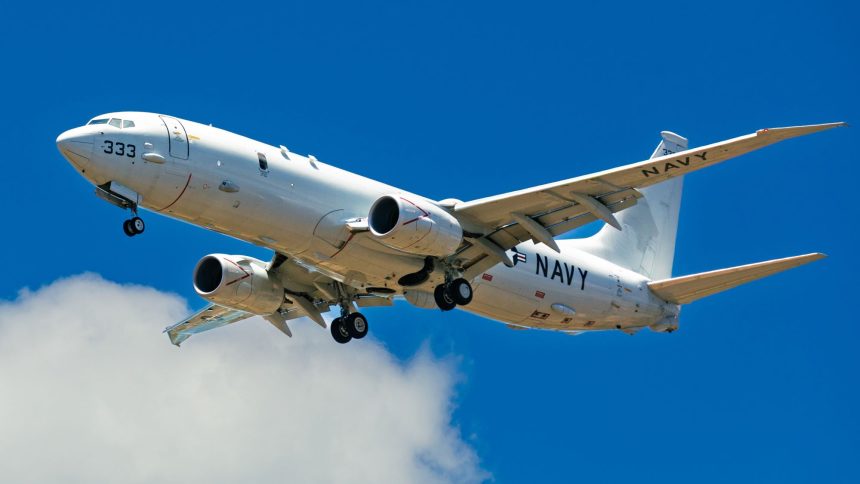The Multi-static Active Coherent Enhancements (MAC-E) is an active sonar system composed of source and receiver sonobuoys used by the P-8 during ASW missions.
The Naval Air Test and Evaluation Squadron (VX-1) announced the completion of the operational testing for the Multi-Static Active Coherent-Enhancements (MAC-E) system on two P-8A Poseidon maritime patrol aircraft at Joint Base-Pearl Harbour Hickam (JBPHH). The test campaign was conducted between Jul. 27 and Jul. 29, 2025, with a total of four sorties.
The U.S. Pacific Fleet and the U.S. Navy published photos of the aircraft while at JBPHH, although they did not specifically identify the system tested as the MAC-E. Instead, the captions generically said the two P-8As from VX-1 were at JBPHH “to test new anti-submarine warfare (ASW) systems before these systems are fielded in the fleet.”
As The Aviationist had reported in June, in context of the first of the seven P-8As completing the Increment 3 Block 2 (I3B2) upgrades, the MACE-E active and passive sonobuoy signal processing system was among the ones for which RTX BBN Technologies Inc. received a $12.8 million contract from NAVAIR (Naval Air Systems Command) on Jun. 18, 2025.
Other systems to be upgraded and installed on the P-8As as part of that contract include the Ground Replay System (GRS), multiple input multiple output (MIMO) capabilities of the new AN/SSQ-101C and the AN/SSQ-125B sonobuoys, undersea advantage (USA) receiver sonobuoy array modifications, new operator machine interface designs, and high-duty-cycle capabilities.
The Navy has described the P-8A as the Navy’s “premier multi-mission aircraft and cornerstone of the Maritime Patrol and Reconnaissance Force (MPRF).” The I3B2 upgrades bring the platform to the fullest extent of its envisaged capability as a full-spectrum ISR, sensing, submarine-hunting and surface-strike aircraft, preserving its relevance through the 2030s.
Limitations of the original MAC
The Multi-Static Active Coherent (MAC) and the improved MAC-E (where the E stands Enhancements) process data gathered by the Navy’s current inventory of sonobuoys (or “remote processors”), designated AN/SSQ-36, AN/SSQ-53, AN/SSQ-62, AN/SSQ-101, and AN/SSQ-125. The Navy integrated the earlier MAC Phase 1 in a classified Final Operational Testing & Evaluation (FOT&E) campaign from March 2014 to February 2015, noted in a DOT&E (Director, Operational Test and Evaluation) report.
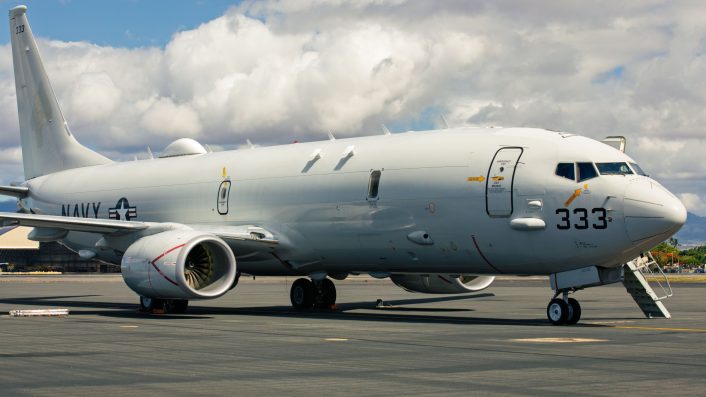
As per the DOT&E, the active sonar MAC system has a “source” and a “receiver” sonobuoy connected to an “acoustic processing and aircraft mission computer software suite.” Also employed by the Navy’s P-3Cs for ASW “in a variety of ocean conditions,” MAC replaced the older Improved Extended Echo Ranging (IEER) system, which used “non-coherent sources to produce loud sounds that reflect off submarine targets.”
“MAC employs new coherent source buoys that enable multiple pings, optimized waveforms, and various ping durations, none of which the legacy IEER system provided,” explained the DOT&E report on FY15 Navy Programs. “The Navy is planning a series of enhancements to the MAC software and improvements to the MAC buoys.”
The system is particularly specialized in “large-area active acoustic searches for threat submarines.” The DOT&E report further said that the classified and more expansive FOT&E results indicate that the MAC Phase 1 provides P-8A aircraft with an “early wide-area” ASW search capability in “some operational environments and in select scenarios, but it does not meet the MAC Phase I program’s requirements in other environments or scenarios.” It must be noted once again that this information dates back ten years.
Detailing the reason for the limitation, the report says the system fell short of “the capability needed to protect high-value units.” Although the P-8A’s higher speed and “revised buoy field installation tactics reduced the search field buoy installation time,” the MAC detection performance was deemed similar to the P-3C’s performance, and independent of the aircraft platform.
The MAC’s detection efficacy is also strongly determined by “characteristics of the ocean environment and the tactics employed by the target to evade detection.” This could refer to how the sonars and sonobuoys operate differently in temperate and cold waters in the north Atlantic and Arctic oceans compared to the hotter, tropical waters of the Indo-Pacific.
While being able to detect “evasive undersea targets,” acoustic operators are also expected to distinguish between submarine and non-submarine sonar clutter that might be mistaken as targets. Here, the MAC’s ability to differentiate target from non-target clutter “varies with environmental conditions,” leading to time being spent on “assessing and prosecuting false targets.”
“Incomplete environmental databases” used by the ASPECT (Active System Performance Estimate Computer Tool) also affected its performance, with the Navy’s Oceanographic Office then “updating these environmental databases, focusing first on forward operating areas.”
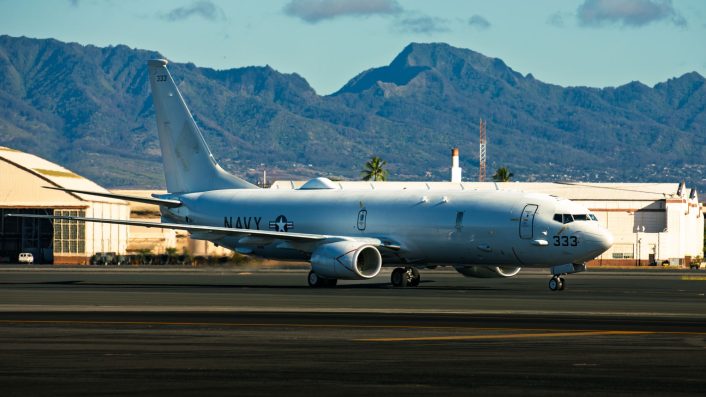
MAC-E
NAVAIR said MAC-E (Multi-Static Active Coherent – Enhancements) capabilities “will include increased search rate, clutter reduction, and Operator-Machine Interface improvements.” On Aug. 15, 2024, NAVAIR contracted Maritime Surveillance Associates to modify the software suite of the Global Reconstruction Analysis and Measurement System (GRAMS) post-flight analysis tool to support the overall MAC-E development and testing.
The modified GRAMS and the P-8A Acoustic Operational Flight Program (AOFP) would function as the MAC-E Post-Flight Analysis (PFA) suite to review data after tests. The contract also required prototyping Artificial Intelligence/Machine Learning (AI/ML) in the GRAMS software modification. GRAMS, certified by the Office of Naval Intelligence (ONI), is used to determine Sound Pressure Level (SPL) of signals radiated by threat of submarines, surface ships, and weapons.
The above information therefore gives us an idea of the capabilities of MAC-E and the testing parameters VX-1 must have focused on in the recent JBPHH deployment. The press releases and the captions described the VX-1’s principal mission being to “test and evaluate airborne anti-submarine warfare, maritime anti-surface warfare, and airborne command and control platforms as well as support systems, equipment and materials in an operational environment.”
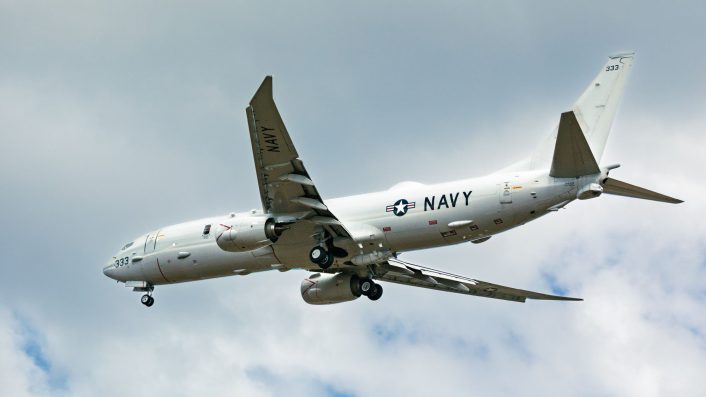
Other P-8A upgrades and improved capabilities
The Aviationist reported in August 2024 about a new Multi-Mission Pod (MMP) developed by Boeing that was spotted on a Navy P-8A Poseidon. Prior to that, in June 2024 we also reported about BAE Systems receiving a $95 million contract to supply an advanced counter-measures and electronic warfare pod to detect and counter inbound radio-frequency threats to protect the P-8A.
Earlier this month, Boeing received a $61 million award for additional production of High Altitude Anti-Submarine Warfare Weapon Capability (HAAWC) kits for Mark 54 torpedoes. The U.S. Navy currently operates 124 P-8A Poseidons, and plans to upgrade its entire planned fleet of 135 P-8As.
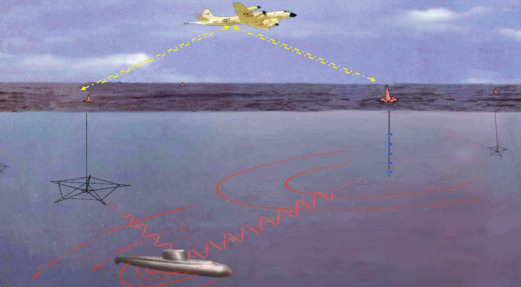
Australia’s 14 Poseidons are also slated to receive I3B2 upgrades. Other than the U.S. and Australia, the P-8A is flown by Germany, U.K., India, South Korea, Norway, New Zealand and, in future, Canada. A total of 185 P-8s are flying today, collectively counting over 660,000 flight hours.

